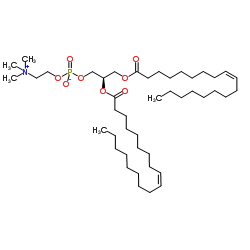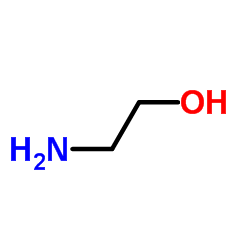DOPE

DOPE structure
|
Common Name | DOPE | ||
|---|---|---|---|---|
| CAS Number | 4004-05-1 | Molecular Weight | 744.034 | |
| Density | 1.008g/cm3 | Boiling Point | 759.2±70.0 °C at 760 mmHg | |
| Molecular Formula | C41H78NO8P | Melting Point | 200 °C | |
| MSDS | Chinese USA | Flash Point | 413.0±35.7 °C | |
| Symbol |


GHS06, GHS08 |
Signal Word | Danger | |
Use of DOPE1,2-Dioleoyl-sn-glycero-3-phosphoethanolamine (DOPE) is a neutral helper lipid for cationic liposome and combines with cationic phospholipids to improve transfection efficiency of naked siRNA[1]. |
| Name | 1,2-dioleoyl-sn-glycero-3-phosphoethanolamine |
|---|---|
| Synonym | More Synonyms |
| Description | 1,2-Dioleoyl-sn-glycero-3-phosphoethanolamine (DOPE) is a neutral helper lipid for cationic liposome and combines with cationic phospholipids to improve transfection efficiency of naked siRNA[1]. |
|---|---|
| Related Catalog | |
| Target |
IC50: helper lipid for liposome[1] |
| In Vitro | In this study, each siRNA is encapsulated in LNP (cationic lipid-A: PEG2000-DMPE: DOPE = 47.8: 5.18: 47.1 molar percent)[1]. With the neutral lipid for the LNP is DOPE, LNP exerts knock-down (KD) effecton macrophages and DCs and Liposome-containing DOPE shows fusogenicity[1]. LNP/siRNA significantly suppresses CD45 protein expression at an inhibition rate of 30% on macrophages and DCs but not on monocytes, neutrophils, plasmacytoid DCs, or B cells[1]. LNP has the potential to be an efficient siRNA delivery system not only for murine but also for human macrophages and DCs[1]. |
| References |
| Density | 1.008g/cm3 |
|---|---|
| Boiling Point | 759.2±70.0 °C at 760 mmHg |
| Melting Point | 200 °C |
| Molecular Formula | C41H78NO8P |
| Molecular Weight | 744.034 |
| Flash Point | 413.0±35.7 °C |
| Exact Mass | 743.546509 |
| PSA | 144.19000 |
| LogP | 14.79 |
| Vapour Pressure | 0.0±5.5 mmHg at 25°C |
| Index of Refraction | 1.484 |
| InChIKey | MWRBNPKJOOWZPW-NYVOMTAGSA-N |
| SMILES | CCCCCCCCC=CCCCCCCCC(=O)OCC(COP(=O)(O)OCCN)OC(=O)CCCCCCCC=CCCCCCCCC |
| Symbol |


GHS06, GHS08 |
|---|---|
| Signal Word | Danger |
| Hazard Statements | H302-H315-H319-H331-H336-H351-H361d-H372 |
| Precautionary Statements | P261-P281-P305 + P351 + P338-P311 |
| Personal Protective Equipment | Eyeshields;Gloves;type N95 (US);type P1 (EN143) respirator filter |
| Hazard Codes | Xn: Harmful; |
| Risk Phrases | R22;R38;R40;R48/20/22 |
| Safety Phrases | 36/37 |
| RIDADR | UN 1888 |
| Hazard Class | 6.1 |
| HS Code | 2931900090 |
|
~90% 
DOPE CAS#:4004-05-1 |
| Literature: Harris; Marshall; Lee; Siegel; Mcneilly; Yew; Nietupski; Nichols; Cherry; Wan; Jiang; Lane; Rowe; Scheule; Smith; Cheng Phosphorus, Sulfur and Silicon and Related Elements, 1996 , vol. 109, # 1-4 p. 289 - 292 |
|
~% 
DOPE CAS#:4004-05-1 |
| Literature: Helvetica Chimica Acta, , vol. 74, # 8 p. 1697 - 1706 |
|
~% 
DOPE CAS#:4004-05-1 |
| Literature: Helvetica Chimica Acta, , vol. 74, # 8 p. 1697 - 1706 |
|
~% 
DOPE CAS#:4004-05-1 |
| Literature: Phosphorus, Sulfur and Silicon and Related Elements, , vol. 109, # 1-4 p. 289 - 292 |
|
~% 
DOPE CAS#:4004-05-1 |
| Literature: Phosphorus, Sulfur and Silicon and Related Elements, , vol. 109, # 1-4 p. 289 - 292 |
|
~% 
DOPE CAS#:4004-05-1 |
| Literature: Journal of the Chemical Society. Perkin transactions 1, , vol. 12, p. 1404 - 1412 |
| HS Code | 2931900090 |
|---|---|
| Summary | 2931900090. other organo-inorganic compounds. VAT:17.0%. Tax rebate rate:13.0%. Supervision conditions:AB(certificate of inspection for goods inward,certificate of inspection for goods outward). MFN tariff:6.5%. General tariff:30.0% |
|
Activation of Tomato Bushy Stunt Virus RNA-Dependent RNA Polymerase by Cellular Heat Shock Protein 70 Is Enhanced by Phospholipids In Vitro.
J. Virol. 89(10) , 5714-23, (2015) Similar to other positive-strand RNA viruses, tombusviruses are replicated by the membrane-bound viral replicase complex (VRC). The VRC consists of the p92 virus-coded RNA-dependent RNA polymerase (Rd... |
|
|
Insights from reconstitution reactions of COPII vesicle formation using pure components and low mechanical perturbation.
Biol. Chem. 395(7-8) , 801-12, (2014) As shape transformations of membranes are vital for intracellular trafficking, it is crucial to understand both the mechanics and the biochemistry of these processes. The interplay of these two factor... |
|
|
Cell-penetrating antimicrobial peptides - prospectives for targeting intracellular infections.
Pharm. Res. 32(5) , 1546-56, (2015) To investigate the suitability of three antimicrobial peptides (AMPs) as cell-penetrating antimicrobial peptides.Cellular uptake of three AMPs (PK-12-KKP, SA-3 and TPk) and a cell-penetrating peptide ... |
| DOPE |
| 9-Octadecenoic acid, (1R)-1-[[[(2-aminoethoxy)hydroxyphosphinyl]oxy]methyl]-1,2-ethanediyl ester, (9Z,9'Z)- |
| Dioleoyl phosphoethanolamine |
| L-A-phosphatidylethanolamine dioleoyl |
| 1,2-dioleoyl-sn-glycero-3-phosphatidylethanolamine |
| 1,2-dioleoyl-sn-glycerol-3-phosphoethanolamine |
| 3-SN-PHOSPHATIDYLETHANOLAMINE,1,2-DIDEOYL |
| MFCD00057986 |
| 1,2-di-O-oleoyl-sn-glycero-3-phosphatidylethanolamine |
| 1,2-Dioleoyl-sn-glycero-3-phosphatidylethanolamine (DOPE) |
| 2-Ammonioethyl (2R)-2,3-bis[(9Z)-9-octadecenoyloxy]propyl phosphate |
| 1,2-dioleoyl-sn-glycero-3-phosphoethanoloamine |
| COATSOME ME-8181 (DOPE) |
| DIOLEOYL PHOSPHATIDYL ETHANOLAMINE |
| 18:1 PE |




![[(E)-octadec-9-enoyl] (E)-octadec-9-enoate structure](https://image.chemsrc.com/caspic/181/6085-36-5.png)
![1,2-DI[CIS-9-OCTADECENOYL]-SN-GLYCERO-3-PHOSPHATE SODIUM SALT structure](https://image.chemsrc.com/caspic/452/108392-02-5.png)

 CAS#:1069-79-0
CAS#:1069-79-0